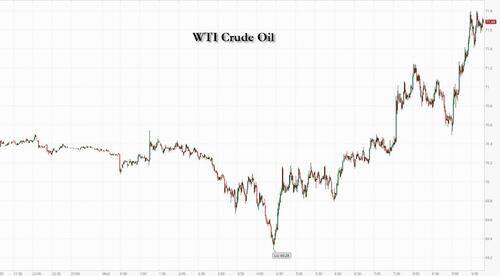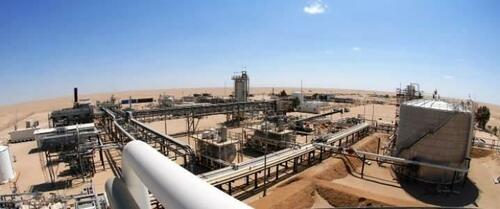Oil Jumps Afrer Libya’s Sharara Oil Field Shut Down By Protesters; Terrorist Attack In Iran
After sliding to fresh multi-week highs yesterday despite a burst of geopolitical risks and adverse escalations – almost as if the intern in charge of the White House oil trading desk was only left with a sell button – WTI rebounded after briefly sliding below $70 this morning and traded near session highs, reversing all of yesterday’s losses after a Bloomberg report that Libya’s Sharara oil field would be shuttered due to protests. The previously noted news that over 100 people have been killed in Iran in a terrorist attack near the grave of former IRGC commander Qassem Soleimani, in a terrorist attack only led to further gains.
As OilPrice notes, after false rumors of the closure of the giant Libyan Sharara oil field on Tuesday, a letter from Libya’s National Oil Company on Wednesday confirmed the shutdown of one of Libya’s most important oil fields.
According to Libya’s Al-Ahrar disgruntled protestors took to the field on Wednesday morning stating that the field would not be re-opened until their demands and those of the entire region of Fezzan in Southern Libya would be met.
In talks with Libya’s Al-Ahrar TV, spokesman Abu Bakr Abu Shreya of protest group the Fezzan Gathering Association demanded better services and development of Southern Libya.
Fears are that the protests may spread to the nearby 60,000 bpd El Feel field.
Sharara produces around 270kb/d, out of Libya’s total 1.2mb/d total output; the last time the field saw a short disruption for the last time in July of 2023 when protests erupted following the arrest of an official who tried to become the boss of Libya’s central bank.
During a period of relative stability following the truce between the rivaling parties in 2020, Libya’s crude oil production has risen to around 1.2 million barrels per day, and Libya’s state oil firm has plans to ramp up production to 2 million bpd by 2030 according to Minister of Oil and Gas Mohamed Oun.
While these disruptions may be relatively short-lived, they will be a reminder that the relative stability in Libya in 2023 has not been the norm in recent years. Libyan production fell below 700kb/d for a couple months in 2022, collapsed for most of 2020, and has been very volatile for years. Oil markets will focus on delivery of the new OPEC+ cuts, on potential risk of disruption from the widening conflict in the region, and on understanding the potential for more of the positive supply surprises we saw last year. However, Libya could be another important variable.
Tyler Durden
Wed, 01/03/2024 – 09:54
via ZeroHedge News https://ift.tt/YN0eAPX Tyler Durden

